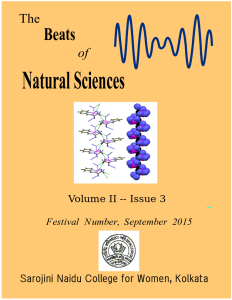ISSN 2348 – 7615
Volume II, Issue 3
Festival Number (September), 2015
From the Desk of the Editors:
 The current issue was scheduled to be published more than a fortnight ago. In spite of utmost effort from our part, we were unable to avoid this enormous delay for the first time, due to certain practical difficulties and we express our earnest regret for that. We previously mentioned that being published from a college, this journal does not have any dedicated editorial team; the teachers of this college do this job side by side their teaching and other academic/administrative assignments. This time assignments of University examinations for the editorial members and certain other technical glitches contributed this delay.
The current issue was scheduled to be published more than a fortnight ago. In spite of utmost effort from our part, we were unable to avoid this enormous delay for the first time, due to certain practical difficulties and we express our earnest regret for that. We previously mentioned that being published from a college, this journal does not have any dedicated editorial team; the teachers of this college do this job side by side their teaching and other academic/administrative assignments. This time assignments of University examinations for the editorial members and certain other technical glitches contributed this delay.
In this issue, six articles are being published; among them half of the articles are research reports and the other half consists of brief review type articles. The articles, in this issue, cover the area of Chemical Sciences and Biological Sciences focussing on varied aspects in these fields of research. ….
Download pdf: From the Desk of the Editors
Brief reports of original research works:
- Catechol Oxidase Activity of New Dinuclear CuII2 and ZnII2 Complexes
Gopal Chandra Giri [dropdown_box expand_text=”Abstract” show_more=”View” show_less=”Hide” start=”hide”]Two new, a dinuclear copper(II) and a dinuclear zinc(II) complexes of an isoindol functionality based new dinucleating ligand, H3hdpa (H3hdpa = 2-({[2-hydoxyethyl]-[2-hydroxy-3-(1-oxo-1,3-dihydro-isoindol-2-yl)-propyl]-amino}-methyl)-benzoic acid) have been synthesized and characterized. In methanol, the reaction of stoichiometric amounts of Cu(OAc)2∙H2O and the ligand, H3hdpa in the presence of NaOH at ambient temperature afforded a new dinuclear copper(II) complex, Na2[Cu2(hdpa)2]∙2CH3OH∙3H2O (1). Similarly, in methanol, the reaction of stoichiometric amounts of Zn(OAc)2·2H2O and H3hdpa in the presence of NaOH yielded a new dinuclear zinc(II) complex, Na4[Zn2(hdpa)2](OAc)2 (2). Characterizations of the complexes have been performed using various analytical techniques including a single crystal X-ray structure determination. The X-ray crystal structure of complex 1 reveals that two copper(II) centers adopt a five-coordinate square pyramidal geometry with Cu—Cu separation of 2.909 Å. The DFT optimized structure of complex 2 shows that two zinc(II) centers are in a distorted trigonal bipyramidal geometry with Zn—Zn separation of 3.124 Å. 1H and 13C NMR spectroscopic investigations authenticate the integrity of complex 2 in solution. Further, the mass spectroscopic analyses of complexes 1 and 2 reconfirm their dimeric nature, even in solution. Variable-temperature (2-300 K) magnetic susceptibility measurements show the presence of antiferromagnetic interactions (J = -52.20 cm-1) between the two copper(II) centers in complex 1. Catechol oxidase activity of complexes 1 and 2 has been investigated in methanol medium by UV-Vis spectrophotometric technique using 3,5-di-tert-butylcatechol as model substrate. Both the two complexes are active in catalyzing the aerobic oxidation of 3,5-di-tert-butylcatechol (3,5-DTBC) to 3,5-di-tert-butylbenzoquinone (3,5-DTBQ). DFT calculation has been performed to find the Fukui functions at the metal centers in complexes 1 and 2 to predict the possible metal centers involved in the binding process with 3,5-DTBC during the catalytic oxidation reactions.[/dropdown_box] Download Full Paper
- Stabilization of a Hydrogen Bonded Left-handed Helical Chain in a Co(III) NNN Donor Schiff Base Complex
Chaitali Biswas [dropdown_box expand_text=”Abstract” show_more=”View” show_less=”Hide” start=”hide”]One mononuclear Schiff base complex of Co(III) [CoL(N3)3] (1) where L = N1-Pyridin-2-ylmethylene-ethane-1,2-diamine was synthesized. The complex was characterized by elemental analysis, IR and UV spectroscopies, and single crystal X-ray crystallography analysis. In complex 1 Co(III) is in a octahedral environment being bonded to three N atoms from the tridentate NNN Schiff base and a terminal N atom of a azide molecule in the equatorial plane and two other N atoms from two different azide molecules attached to the axial positions. Complex 1 forms a hydrogen bonded left handed helical chain along [010] direction. [/dropdown_box] Download Full Paper
- Effect of Subunits of Mrigal (Cirrhinus mrigala) Vg (HA-I) on Catfish Vitellogenesis
Raju Sahu and Panchanan Nath [dropdown_box expand_text=”Abstract” show_more=”View” show_less=”Hide” start=”hide”]Two forms of mrigal (Cirrhinusmrigala) vitellogenin (HA-I and HA-II) were purified and HA-I was found to induce complete vitellogenesis when administered to the Indian catfish, Clarias batrachus (Nath and Maitra, 2001). Therefore, in the present study, two major subunits of HA-I (subunit-I or SUI: 160 kDa and SUII: 83 kDa) were purified and tested along with trypsin digested HA-I for their role in catfish vitellogenesis. 10-day treatment of female catfish @ 1 mg/fish/day revealed that in SUII and TDH-treated groups the fully formed yolky oocytes (SIII) were present in the ovarian section. Since SUII is of 83 kDa protein and TDH also contain similar molecular weight (~75 kDa) protein and are most effective in the formation of SIII oocytes the 83 kDa (SUII) protein may possibly the regulator of vitellogenesis. [/dropdown_box] Download Full Paper
Review on current frontiers or historical milestones:
- Role of Thiourea and its Derivatives as N,S Donor Ligand
Sandip Mukherjee [dropdown_box expand_text=”Abstract” show_more=”View” show_less=”Hide” start=”hide”]Ligands with nitrogen and sulphur as potential site for coordination have vast effect on coordination chemistry. Nitrogen being ‘border line’ can coordinate with both hard and soft transition metal ions. On the other hand sulphur preferably binds with soft metal ions. So thiourea and its derivatives would bind with all most all metal ions. Several research works have been carried out using thiourea and its derivative as ligand to study the mode of coordination of the ligand and to study geometry, spectroscopic behavior, magnetic properities and antibacterial and antitumor activities of the prepared complexes with various transition metals. The present article is to review and summarize such major research works in this area. [/dropdown_box]Download Full Paper
- Custodian Farmers and the Mango Legacy of India
Mitu De[dropdown_box expand_text=”Abstract” show_more=”View” show_less=”Hide” start=”hide”] Mango (Mangifera indica L.) one of the most important commercially grown fruit crop of India. India has the richest collection of mango cultivars with mango being grown in all the states of the country. Different varieties have unique taste, flavour, texture and size. In recent times molecular genomics technologies are being used to assist our understanding of mango genetics and the diversity of the mango gene-pool. It is of prime importance that these varieties be conserved for further mango improvement or mango genetics study. Custodian farmers have been maintaining, promoting and adapting a wide range of indigenous fruit tree varieties on their farms. These custodian farmers protect, nurture and propagate the rich mango legacy of India. One of the strategies of conserving diversity, on-farm, is identification of custodian farmers and extending support to them. [/dropdown_box]Download Full Paper
- Ladybirds to the rescue: The aphidophagous ladybird beetle as a bio-control agent
Santi Ranjan Dey[dropdown_box expand_text=”Abstract” show_more=”View” show_less=”Hide” start=”hide”] The aphidophagous ladybird beetle is one of the potential predators of the mustard aphid, Lipaphis erysimi (Kaltenbuch) which is a key pest of the rapeseed and mustard. Mustard is a very important oilseed crop and constitute the major source of edible oil in India. The development of resistance to pesticides and toxicity to the non target organism is largely responsible for the attention on biological control. The bio-control agents like coccinellids and others have been reported to be effective for controlling the aphid, Liphapis erysimi. Biological control is an environmentally sound and effective means of reducing or mitigating pests and pest effects through the use of natural enemies. [/dropdown_box]Download Full Paper
Contact Informations :
| Publisher: Principal, SAROJINI NAIDU COLLEGE FOR WOMEN |
Address: SAROJINI NAIDU COLLEGE FOR WOMEN,30, Jessore Road, Dumdum, Kolkata 700028, India | Phone No.: +91-33-2559 2583 email: info@sncwgs.ac.in |
| Editors: Dr. Sonali Saha Dr.Soma Aditya Bandyopadhyay Dr. Chaitali Biswas |
Address: SAROJINI NAIDU COLLEGE FOR WOMEN,30, Jessore Road, Dumdum, Kolkata 700028, India | Phone No.: +91-33-2559 2583 email:editors.bns@sncwgs.ac.in |
 Pay Your Fees
Pay Your Fees 


